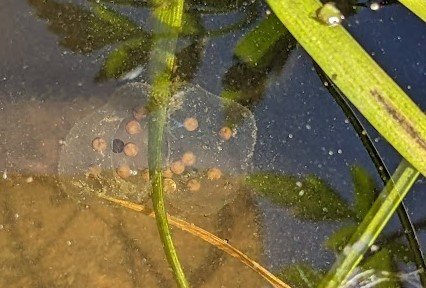The Amphibians of the Issaquah Alps
Article by Sally Lawrence and Hilary Barnes
One of the many reasons to SAVE COAL CREEK is to protect and improve the existing wildlife corridor between Cougar Mountain Regional Wildland Park and Bellevue’s Coal Creek Natural Area. Not just for the big guys like deer and bear, or the owls and hawks that search for prey in the Milt Swanson pasture, but also for the little guys – amphibians such as salamanders and frogs.
Amphibians are thin-skinned – they depend on wetlands and streams for the egg-laying part of their lives, and some species need wet habitats for much longer. They are the only vertebrate animals without fur, scales or feathers and are considered "indicator species." The health, diversity and numbers of amphibians breeding in and around our ponds and forests reflect the quality of the environment around them.
Northern Red-legged Frog
The Coal Creek watershed has streams and wetlands, starting high on Cougar Mountain at Klondike Marsh (1200 ft elevation) and likely some springs as well, so there is ample amphibian habitat.
Two Save Coal Creek volunteers, Hilary Barnes and Sally Lawrence, conducted amphibian surveys at Klondike Marsh in 2022 and 2023 as part of a Woodland Park Zoo (Seattle) citizen science project. The surveys are conducted with permission from King County Parks, which also generously supplied volunteers to help with the surveys when the team was short-handed. The surveys don’t involve collecting animals; instead they rely on photographs of egg masses, tadpoles and adults. The photos are submitted to the Zoo’s project site on iNaturalist, a global online platform for digital records of flora and fauna. The Zoo provides training for volunteers and assembles teams of 4 or 5 for each site. Besides Hilary and Sally, the 2023 Cougar Mountain team included Lynn Putnam, Dana Kendrick and Nikki Furner.
Hilary says, “We have learned that context matters deeply, and that patient and repeated visits to a place make the familiar unfamiliar as new questions arise and unsolved mysteries appear. We’ve seen many egg masses - but it’s more difficult to document the juvenile stages. So we wonder, how many hatchlings survive and populate the woods?”
Pacific Tree Frog egg mass
During the two seasons, the volunteers recorded the presence of adults, tadpoles and/or egg masses of Northern Pacific Tree Frog; Northwestern Salamander; Red Legged Frog; and Long-toed Salamander at Klondike Marsh. Nearby, but outside the project site, they also observed a Rough-skinned Newt , a land-breeding Western Red-backed Salamander and a Coastal Giant Salamander.
Hilary noted that many amphibians have the capacity to regenerate tails or legs in response to attack by a predator, but they cannot recreate a healthy breeding environment. So all of us who live or recreate nearby have a stake in preserving these habitats. She says, “Please tread carefully and respectfully near streams and wetlands.”
You can contribute to our understanding of the flora and fauna of the Issaquah Alps by creating a personal iNaturalist account. Whether you photograph a woodpecker in the forest or the skunk cabbage along the trail, additional records on iNaturalist will increase awareness and understanding of the amazing nature all around us.


